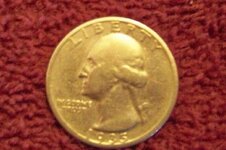Jolly Jim
Tenderfoot
- Feb 8, 2005
- 9
- 0
- Detector(s) used
- Fisher CZ70, Fisher 1280X
After about a minute of electrolysis using a 12 volt, 1200 mA cleaning set-up, this previously cruddy quarter turned out slightly tarnished. I continued to let it fizz for another minute and was impressed at how clean it turned out. Does prolonged electrolysis wear away at the metal? Also, does silver react differently than copper? I was always told that cleaning reduces value. How does cleaning using electrolysis apply? I'm also seeing better results using a concentration of lemon juice and salt. It's been fun experimenting with with this technique and I would appreciate some tips from the experts out there!! Thanks! 






